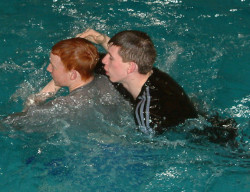Defenses and Escapes
This lesson is an introduction to aquatic self-defence. The aim is to perform escapes blindly, day or night, no matter what.
Defences
Whenever a casualty tries to grab you, reverse onto your back and kick your legs to create a safe distance. This also communicates to them that grabbing you is not part of the rescue plan.
When a lifesaver is grabbed by a drowning casualty it is almost too late. The rescuer can be in extreme danger because panicking casualties can be very strong.
During any rescues, the rescuer needs to keep a safe distance from any panicking casualty. Rescue operations should always be conducted so that the rescuers can not be grabbed by any casualties.
Whenever you can, try a rescue from the shore or poolside first. If not possible, swim up to the casualties only so close that they can not grab you.
Nevertheless, there are situations where a swimmer is grabbed by another unexpected casualty,
as in an accident with several people or even seemingly harmless lay in the pool
when a weak swimmer gets water on his face and starts to panic.
Escape Patterns
Releases always follow the same pattern, no matter what the grip. If a stranglehold can't be avoided, the rescuer immediately presses his chin on his chest and pulls the shoulders up. Then he crosses his arms over his face. This measure avoids that the rescuer is grabbed by the neck.
Use leverage to free yourself. Pull a finger or toe to loosen the casualty's grip. Poke them underneath their arms, which often makes them let go.
The rescuer tries to escape by submerging and then pushing away to safety. Releases should always be practiced underwater, as drowning victims always try to stay afloat, and so the possibility exists that this loosens their grip.

Be careful when you are grabbed from behind.


Regain control or keep clear.
Techniques
Below are a few techniques you can use to free yourself when a panicking casualty holds on to you. As soon as you are free, get away from the casualty, turn on your back and kick your legs like in backstroke to make a big splash.
All escape methods can also be carried out in mirror image. We simply assume in our descriptions you are right-handed. Feel free to amend this to your needs.
Wrist Grab
When a casualty grab you by the wrist with one hand, swing your hand around in a way that moves against their thumb.
If they grab you with both hands,
reach between their arms and get a good hold of your hand.
Pull up (or down) against their thumbs and they have to let go.
Neck choke from the front
When you are near panicking casualties, there is a risk that you can get choked on the neck. Grasp the wrist of the attacker with one hand, and push his/her chin back. Be careful not to touch the neck or throat.
An alternative is to move your hands up between the casualty's arm and do a breaststroke move to break their hold.
Neck chocke from behind
This is particularly dangerous. as the rescuer is often surprised by an attack from behind.
Grab the upper hand and the elbow of the casualty.
Twist yourself out of the strangle hold.
Bear hug from the front
This is harder to solve than above because the space for movement is reduced significantly. Hold the casualty below their armpits, turn your head sideways so your nose doesn't get caught in the casualty's clothing or zippers. Push the casualty upward and escape to the side.
If you can free yourself start swimming breaststroke, thus submerging the casualty. They will let go eventually.
Bear hug from behind
Grab the upper hand and the elbow of the casualty. Twist yourself out of the strangle hold and push the casualty away.
If you can free yourself start swimming backstroke, thus submerging the casualty.
They will let go eventually.
Waist grab from front (push down)
If the casualty grabs you around the waist from the front, get hold of his elbows and push down, as if taking off a pair of jeans. Escape backwards.
Waist grab from behind (airline seatbelt)
When you are held from behind,
find a finger of the casualty's upper hand and pull outwards,
as if opening the latch of an airline seatbelt.
This should free you so you can turn and get away,